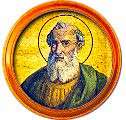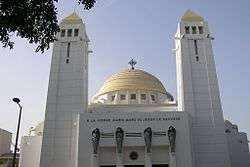Catholic Church in Africa

The Catholic Church in Africa refers to parts of the Catholic Church in the various countries in the continent of Africa.
Christian activity in Africa began in the 1st century when the Patriarchate of Alexandria in Egypt was formed as one of the four original Patriarchs of the East (the others being Constantinople, Antioch, and Jerusalem).
However, the Islamic conquest in the 7th century resulted in a harsh decline for Christianity in northern Africa.
Yet, at least outside of the Islamic majority parts of northern Africa, the presence of the Catholic Church has recovered and grown in the modern era in Africa as a whole. Catholic Church membership rose from 2 million in 1900 to 140 million in 2000.[1] In 2005, the Catholic Church in Africa, including Eastern Catholic Churches, embraced approximately 135 million of the 809 million people in Africa. In 2009, when Pope Benedict XVI visited Africa, it was estimated at 158 million.[2] Most belong to the Latin Church, but there are also millions of members of the Eastern Catholic Churches. By 2025, one-sixth (230 million) of the world's Catholics are expected to be Africans.[3]
The world's largest seminary is in Nigeria, which borders on Cameroon in western Africa, and Africa produces a large percentage of the world's priests. There are also 16 Cardinals from Africa, out of 192, and 400,000 catechists. Cardinal Peter Turkson, formerly Archbishop of Cape Coast, Ghana, is Africa's youngest Cardinal at 64 years old,[2][4] and was also one of several prelates from Africa estimated as papabile for the Papacy in the last papal conclave of 2013.
History
Ancient era
Many important members of the early Church were from Africa, including Mark the Evangelist, Origen, Tertullian, Saint Augustine of Hippo (from Hippo Regius in what is now Annaba, Algeria[5]) and Clement of Alexandria. Churches in eastern North Africa, such as those in Egypt and Ethiopia, tended to align with the practice of the Eastern Church, but those to the West (the area now known as the Maghreb) were connected to the Roman Church. Three early popes were from the Roman Africa Province. These were Pope Victor I (reigned c . 189 to 199), Pope Miltiades (reigned 311 to 314) and Pope Gelasius I (492 to 496) and all of them were Christian Berbers.
Islamic conquest
The conventional historical view is that the conquest of North Africa by the Islamic Umayyad Caliphate between AD 647–709 effectively ended Catholicism in Africa for several centuries. A prevailing view is that the Catholic Church at that time lacked the backbone of a monastic tradition and was still suffering from the aftermath of heresies including the so-called Donatist heresy, and this contributed to the earlier obliteration of the church in the present day Maghreb. Some historians contrast this with the strong monastic tradition in the Coptic Church of Egypt, which is credited as a factor that allowed Coptic Church to remain the majority faith in that country until around after the 14th century.
However, new scholarship has appeared that disputes this. There are reports that the Catholic faith persisted in the region from Tripolitania (present-day western Libya) to present-day Morocco for several centuries after the completion of the Islamic conquest by 700 A.D.[6] There are currently archaeological excavations in western Libya that are focused on the remains of Christian churches dated from the 10th century. There is also evidence of religious pilgrimages after 850 A.D. to tombs of Catholic saints outside of the city of Carthage, and evidence of religious contacts with Christians of Islamic Spain. In addition, calendar reforms adopted in Europe at this time were disseminated amongst the indigenous Christians of Tunis, which would have not been possible had there been an absence of contact with the Holy See in Rome. Jonathan Conant (Staying Roman, Conquest and Identity in Africa and the Mediterranean, 439-700, Cambridge, 2012, pp. 362-370) reviews the evidence. He states that Islam did not become the majority in Tunisia until quite late in the 9th century and the "vast majority until some time in the tenth," (pp. 363-64). Christians tended to live in towns and cities and often spoke African Latin, "al-Latini al-Afriqi", until "at least the 12th century" (ibid. p. 363). By 1076 there were only two bishops left in Africa. Pope Gregory had to appoint a third in order to bring up the number to three to consecrate a new Bishop of Hippo Regius. The decline of Christianity was hastened in part by the destruction wrote by the invasion of the Banu Hilal, sent by the Fatimids in Cairo to punish the Zaid Sunni Islamic emirs. This resulted in the arabization of Tunisia up till then Berber and Latin speaking. In 1159-1160 many of the remaining Christians were evacuated by the Normans to Sicily.
It does look like local Catholicism came under enormous pressure around the time that the Muslim fundamentalist regimes of the Almohads and Almoravids came into power, and the record shows demands made of the local Christians of Tunis to convert to Islam. We still have reports of Christian inhabitants and a bishop in the city of Kairoun around 1150 A.D. - a significant report, since this city of founded by Arab muslims around 680 A.D. as their administrative center after their conquest. A letter in the Catholic Church archives from the 14th century shows that there were still four bishoprics left in North Africa, admittedly a sharp decline from the over four hundred bishoprics in existence at the time of the Islamic conquest.
Modern era
By 1830, when the French came as colonial conquerors to Algeria and Tunis, local Catholicism had been extinguished. The growth of Catholicism in the region after the French conquest was built on European colonizers and settlers, and these immigrants and most of their descendants left when the countries of the region became independent.
Eastern Catholic Churches
The Latin Church remains the largest throughout the continent. However, in eastern Africa, there has been an emergence of Alexandrian Rite Eastern Catholic Churches: the Coptic Catholic Church, the Ethiopian Catholic Church, and the Eritrean Catholic Church (2015).
Catholic Monarchs
Despite with prevalent republican governments in contemporary time, Africa has a tradition of Catholic monarchs, such as in the kingdoms of Congo, Uganda, Rwanda, and Burundi.
Modern African papabili

In 1920 Hilaire Belloc had proclaimed, "The Church is Europe, and Europe is the Church." However, according to Philip Jenkins, the 20th century saw major changes for the Catholic Church. By 1960, the College of Cardinals had its first African, Laurean Rugambwa. By deliberate policy, John Paul II selected many Cardinals from Third World nations, and by 2001 they made up over 40 percent of the body.[7] In 2002, Italian Cardinals made up just 15 percent of the College, a drop from 60 percent in the 1950s.[8]
Jenkins saw the conservatism of Pope John Paul II as particularly attractive to Catholics in developing nations and likely to be a dominant force in Catholic politics for some time.[7] Francis Arinze, a Nigerian Cardinal and adviser to Pope John Paul II, was considered papabile before the 2005 papal conclave, which elected Benedict XVI.[9] As Arinze was considered theologically conservative, Jenkins suggests he would have brought African "notions of authority and charisma" to the office, rather than democracy.[7]
Jenkins states, "The prospect of a Black African pope understandably excites Christians of all political persuasions."[7] Even Cardinal Joseph Ratzinger, three years before his own selection as Pope, labeled the prospect of an African pope as "entirely plausible" and a "wonderful sign for all Christianity."[8] According to Financial Times, an African such as Arinze would "boost the popularity" of the church, which is facing strong competition in Africa from Pentecostal, Baptist, and Evangelical denominations.[10] The Daily Telegraph has said that an "African papacy is the logical outcome" given that the majority of Catholics now live in the developing world, and in particular, the Catholic Church in Africa "has grown by 20 times since 1980."[8]
In the papal conclave of 2013, Cardinal Peter Turkson of Ghana was called "the most likely" candidate from Africa and was considered the favorite to win the papacy before the election of Jorge Mario Bergoglio in 2013.[11]
Issues
Islamist persecution
Persecution of Christians by Islamists, such as Boko Haram in Nigeria, remains one of the hardest issues to solve for the Catholic Church in Africa.
Celibacy
Although Catholic priestly vow of celibacy is a general challenge for all priests in the Catholic Church, for instance because of cultural expectations for a man to have a family, Africa presents particular problems in the subject. Early in the 21st century, as celibacy continued to come under question, Africa was cited as a region where the violation of celibacy is particularly rampant. Priests on the continent were accused of taking wives and concubines. Isolation of priests working in rural Africa, and the low status of women, is said to add to the temptation. A breakaway sect of married previously Catholic priests in Uganda, called the Catholic Apostolic National Church, formed in 2010 following the excommunication of a married priest by Pope Benedict XVI.[12]
See also
- List of African popes
- List of saints from Africa
- Roman Catholicism in Asia
- Roman Catholicism in North America
- Roman Catholicism in South America
- Roman Catholicism in Australia
- Roman Catholicism in Europe
- Christian Berbers
References
- ↑ The Catholic Explosion, Zenit News Agency, 11 November 2011
- 1 2 Rachel Donadio, "On Africa Trip, Pope Will Find Place Where Church Is Surging Amid Travail," New York Times, 16 March 2009.
- ↑ David Barrett, International Bulletin of Missionary Research, Vol. 30, No 1, January 2006, 29.
- ↑ "Synod to Address Ethnic and Religious Divisions," America, 12 October 2009.
- ↑ "Bona, Algeria". World Digital Library. 1899. Retrieved 2013-09-25.
- ↑ Last autochthonous Christians in the Maghreb (in French)
- 1 2 3 4 Philip Jenkins (2002). The Next Christendom: The Coming of Global Christianity. Oxford University Press. ISBN 0-19-514616-6.
- 1 2 3 Bruce Johnston (April 5, 2002). "King-maker cardinal hints at possibility of African pope". Sydney Morning Herald. Retrieved 2008-04-20.
- ↑ Carroll, Rory. 2003, October 3. "The Guardian Profile: Francis Cardinal Arinze." The Guardian.
- ↑ Andrew England (April 4, 2005). "Kenyans pledge to carry on papal projects". Financial Times. Retrieved 2008-04-20.
- ↑ Greg Watts (November 2, 2007). "A mission to speak out of Africa". The Times. Retrieved 2008-04-20.
- ↑ Lisa Miller (April 7, 2010). "The trouble with celibacy". Newsweek. Retrieved 2010-04-09.
